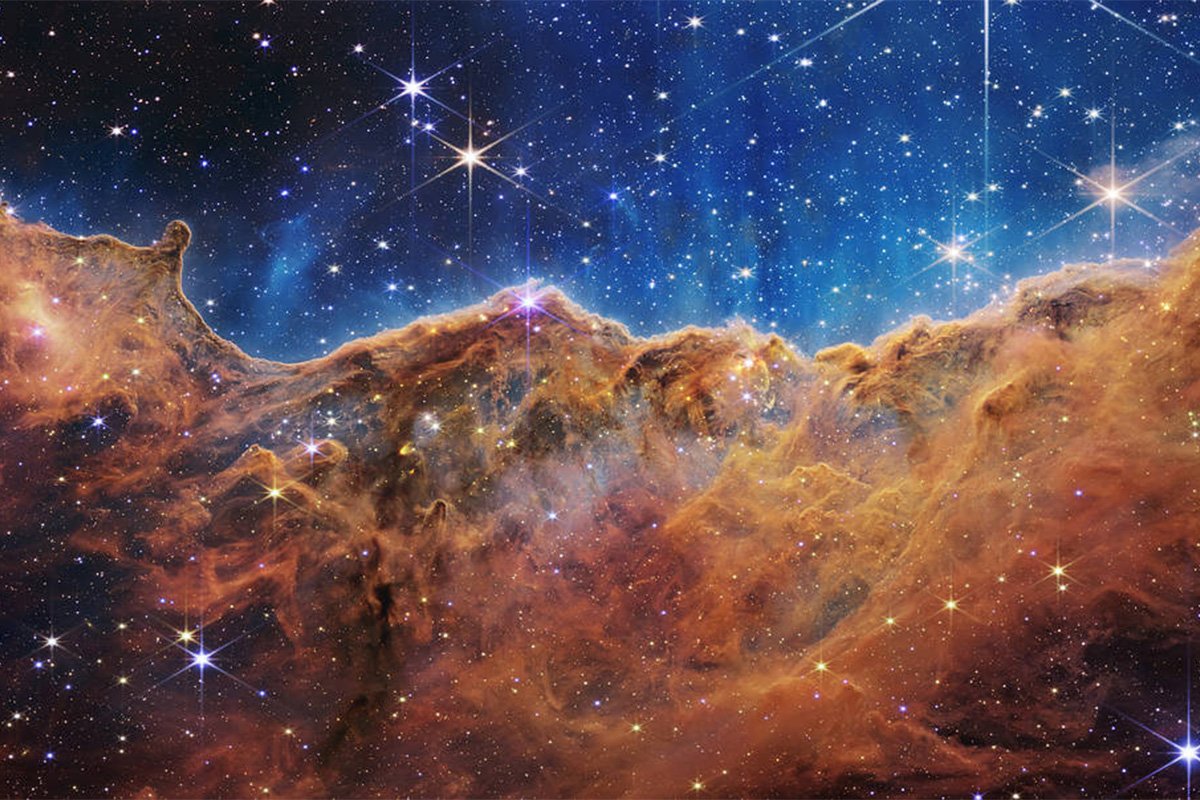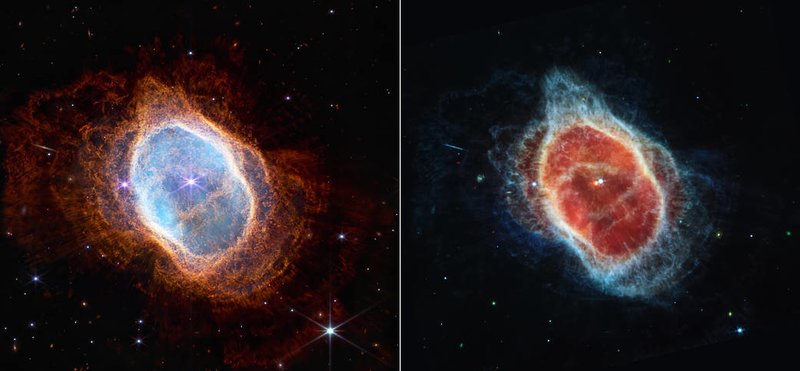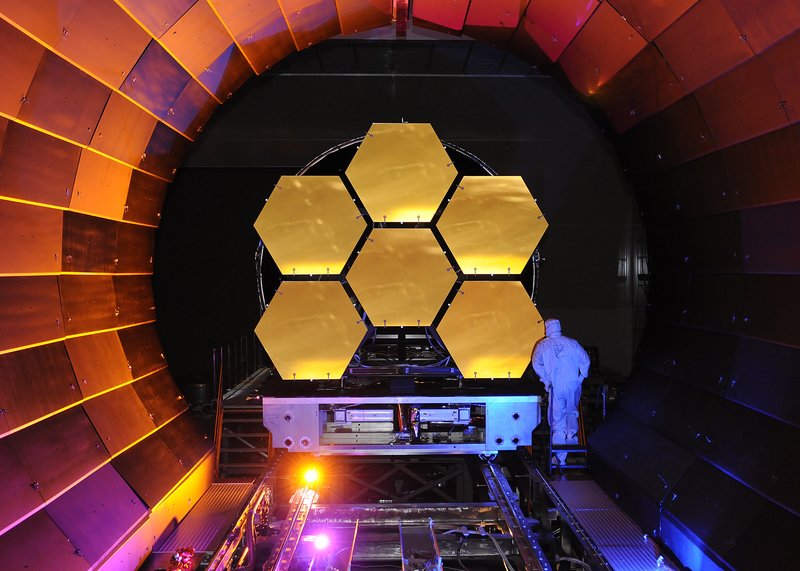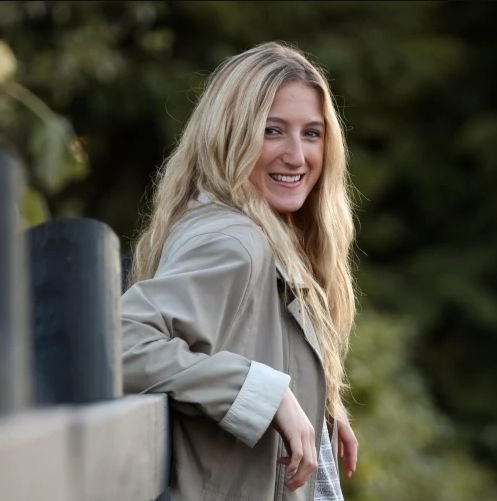
Captured by NASA's new James Webb Space Telescope, this image reveals previously invisible areas of star birth in the Carina Nebula. The tallest "peaks" in the image are 7 light-years high. NASA photo.
A breathtaking landscape of mountain and valley-like shapes dotted with stars actually depicts the edge of a young, star-forming region thousands of light-years from Earth in one image captured by NASA’s new James Webb Space Telescope. The groundbreaking photos released this week by NASA reveal previously invisible emerging stellar nurseries and new details about distant galaxies for the first time ever.
NASA began sharing photos from its multibillion-dollar telescope Monday, July 11, with more images following on Tuesday on the space agency’s website. Scientists are also showcasing the photos in New York City’s Times Square and Piccadilly Circus in London, more than six months after the Webb telescope was launched.
“Absolutely thrilling!” John Mather, Webb senior project scientist and cosmologist, said in a NASA press release. “The equipment is working perfectly, and nature is full of surprising beauty. Congratulations and thanks to our worldwide teams that made it possible.”

Webb's powerful infrared view brings the second star of this nebula's death into full exposure, also showing pinpricks of light in the distant background — entire galaxies — brought into focus by the telescope's exceptional capabilities and cutting-edge scientific instruments. NASA scientists hope to use the James Webb Telescope to understand how galaxies and stars form, and subsequently how they shape the environment surrounding them.
After more than 20 years of development, NASA launched the JWST on Christmas Day 2021 in a highly anticipated event for scientists and the public as the pricey endeavor set sail for answers to the questions surrounding the early beginnings of the universe.
The first batch of images showcase five regions of space researchers targeted: the Carina Nebula; Stephan’s Quintet, a grouping of five galaxies; the Southern Ring Nebula; the WASP-96 b exoplanet; and the galaxy cluster SMACS 0723, also known as Webb’s First Deep Field.
The White House and NASA revealed the first image Monday, showing the galaxy cluster known as Webb’s First Deep Field, which contains thousands of individual galaxies. The final picture is a composite, made from images at different wavelengths over the course of 12 1/2 hours.
According to NASA, the picture shows the galaxy cluster as it existed 4.6 billion years ago and achieved depths “at infrared wavelengths beyond the Hubble Space Telescope’s deepest fields, which took weeks.”

NASA created this composite image of galaxy cluster SMACS 0723, also known as Webb's First Deep Field, using images made at different wavelengths over the course of 12.5 hours. It shows the galaxy cluster as it appeared 4.6 billion years ago and contains thousands of galaxies visible for the first time. NASA photo.
Researchers will continue taking even longer exposures with Webb in hopes of learning more “about the galaxies’ masses, ages, histories, and compositions.”
The Webb telescope uses 18 hexagonal, gold-covered beryllium mirrors spanning 21 feet to analyze the heat and infrared light from the edge of the universe — the only signatures left from dead stars.
It is among the most expensive space platforms in history, “comparable only to the Hubble Space Telescope and the Large Hadron Collider at CERN,” according to a 2021 Planetary Society article. The Planetary Society estimates the telescope will cost NASA $9.7 billion over 24 years, most of it spent between 2003 and 2021; however, that isn’t the project’s total cost. The European Space Agency contributed around 700 million euros, and the Canadian Space Agency gave approximately C$200 million.

Fully assembled, the James Webb Space Telescope has 18 hexagonal mirrors that see infrared light similar to the way a photography camera uses long exposures in dim lighting. Photo courtesy of Ball Aerospace.
The Webb takes its name from NASA’s second administrator, James E. Webb, a Marine Corps veteran and longtime public servant who led NASA from 1961 to 1968. While President John F. Kennedy had pledged to land a man on the moon before the end of the decade, Webb thought the space program should be more than a political tool.
“Webb believed that NASA had to strike a balance between human space flight and science because such a combination would serve as a catalyst for strengthening the nation’s universities and aerospace industry,” NASA’s website reads.
That vision spurred the development of robotic spacecraft and more than 75 space science missions to study the stars and galaxies by the time man first set foot on the moon in July 1969, making Webb an apt choice to lend his name to the world’s newest space observatory.
You can keep track of the Webb telescope’s location with NASA’s tracking tool.
Read Next: NASA Set To Launch Its Massive James Webb Space Telescope on Christmas

Lauren Coontz is a former staff writer for Coffee or Die Magazine. Beaches are preferred, but Lauren calls the Rocky Mountains of Utah home. You can usually find her in an art museum, at an archaeology site, or checking out local nightlife like drag shows and cocktail bars (gin is key). A student of history, Lauren is an Army veteran who worked all over the world and loves to travel to see the old stuff the history books only give a sentence to. She likes medium roast coffee and sometimes, like a sinner, adds sweet cream to it.

Hannah Ray Lambert is a former staff writer for Coffee or Die who previously covered everything from murder trials to high school trap shooting teams. She spent several months getting tear gassed during the 2020-2021 civil unrest in Portland, Oregon. When she’s not working, Hannah enjoys hiking, reading, and talking about authors and books on her podcast Between Lewis and Lovecraft.
BRCC and Bad Moon Print Press team up for an exclusive, limited-edition T-shirt design!
BRCC partners with Team Room Design for an exclusive T-shirt release!
Thirty Seconds Out has partnered with BRCC for an exclusive shirt design invoking the God of Winter.
Lucas O'Hara of Grizzly Forge has teamed up with BRCC for a badass, exclusive Shirt Club T-shirt design featuring his most popular knife and tiomahawk.
Coffee or Die sits down with one of the graphic designers behind Black Rifle Coffee's signature look and vibe.
Biden will award the Medal of Honor to a Vietnam War Army helicopter pilot who risked his life to save a reconnaissance team from almost certain death.
Ever wonder how much Jack Mandaville would f*ck sh*t up if he went back in time? The American Revolution didn't even see him coming.
A nearly 200-year-old West Point time capsule that at first appeared to yield little more than dust contains hidden treasure, the US Military Academy said.












